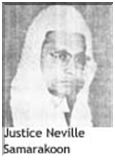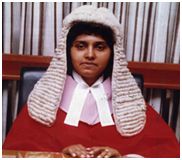The 18th Amendment to the Constitution, which ended all the debates and discussions on the 17th Amendment, brought an end to all independent public institutions in Sri Lanka. From that point on, only one institution remained outside the complete control of the executive president. That was the judiciary.
True, that institution itself had been seriously undermined since the 1972 and 1978 Constitutions. The 1978 Constitution conceptually displaced the idea of the independence of the judiciary. However, a 200-year-old tradition of an independent judiciary could not be wiped out merely by a constitutional change. At ground level the institution and the people who had been trained under the ‘old’ framework were still there. More than that, a belief had been created over those 200 years that in court it was possible to obtain justice. And this was difficult to erase.
 This gave rise to a contest between the executive president and Neville Samarakoon QC, the first Chief Justice under the new constitution. One of the issues that no one has yet explained is as to how a person with such legal erudition and integrity as Neville Samarakoon could have not seen the pernicious effect of the 1978 Constitution on democracy as a whole and on the independence of the judiciary in particular. Surely, as one of the leading civil lawyers of the time, he would have had some understanding of the basic principles of constitutionalism. That the ruler cannot be above the law is so basic a premise that it is difficult to fathom how Neville Samarakoon failed to understand it when he agreed to be the Chief Justice under the new constitution, in which the basic premise was that the executive president was above the law.
This gave rise to a contest between the executive president and Neville Samarakoon QC, the first Chief Justice under the new constitution. One of the issues that no one has yet explained is as to how a person with such legal erudition and integrity as Neville Samarakoon could have not seen the pernicious effect of the 1978 Constitution on democracy as a whole and on the independence of the judiciary in particular. Surely, as one of the leading civil lawyers of the time, he would have had some understanding of the basic principles of constitutionalism. That the ruler cannot be above the law is so basic a premise that it is difficult to fathom how Neville Samarakoon failed to understand it when he agreed to be the Chief Justice under the new constitution, in which the basic premise was that the executive president was above the law.
The debate throughout the period of the coalition government (1970-1977), particularly within the legal community, was about the attack made through the 1972 Constitution on the independence of the judiciary. It replaced the notion of the supremacy of the law with the supremacy of the parliament. This meant that parliament could make any law, because of the removal of the powers of judicial review that the judiciary had enjoyed until then. In fact, judicial review was what gave the power and the punch to the judiciary. In at least one instance, even in the colonial days, an order by the governor representing the British Crown was declared null and void and quashed by the then Chief Justice. This was in the well known case of Bracegirdle. Neville Samarakoon QC could not have failed to realise that if a similar situation arose under the 1978 Constitution an order of the executive president could not be so quashed by the Supreme Court of Sri Lanka, as Article 35 (1) of this constitution ensured that no law suits could be brought against the executive president in any court of law.
Mr. Neville Samarakoon QC and many others like him could have done better if they had initially rejected the 1978 Constitution rather than when they rebelled against the executive president when he began to bring into effect what he designed the 1978 Constitution for, which was to have absolute power. It is said by many who knew Neville Samarakoon QC that he regretted his mistake bitterly until the time of his death.
It was when J.R. Jayewardene found that the Chief Justice was not under his control that he brought the first impeachment move under the 1978 Constitution. Since then, whenever the impeachment provisions are used, it is done under the same circumstances and for the same purpose.
The Chief Justices who came after Neville Samarakoon understood the new equation and did all they could to avoid any kind of confrontation. In that way they weakened the judiciary and also the peoples’ faith in their independent function.
When Sarath N. Silva became the Chief Justice he understood the equation very well and made it his business to support President Chandrika Bandaranaike until the very end, up to the point when he realised that the future did not lie with her. Then he shifted his alliance to Mahinda Rajapaksa and kept up the supportive link to the executive until finally, for reasons best known to himself, their relationship faltered.
Sarath N. Silva makes many speeches now and, at times, expresses partial regret for his allegiance to the executive. However, by then irreparable damage had been done to the power, as well as the image, of the judiciary.
Over the years this situation led to the creation of disillusionment among the people as well as the lawyers. The following quote from S.L. Gunasekara’s recent book Lore of the Law and other Memories reflects the demoralisation caused by the weakening of judicial independence. In answer to a question from a junior lawyer: “Sir, is Hulftsdorp much different today to what it was when you joined the Bar?” He replied, “When I joined the Bar we had no air conditioners, no computers, no lifts, no ponds inside the Supreme Court premises, no photocopying machines or free trips abroad sponsored by the Government or nongovernmental organisations; but we had justice………I did not, by this, mean to say that there is no justice whatever done in the courts today, (in that some measure of justice is done) but that the difference between then and now lay chiefly in the fact that while there were doubtless many shortcomings in the administration of justice even in those days which we nostalgically recall as having been the gold old days, that was a time when we almost always won good cases and lost bad cases whereas today, there are so many occasions when we lose good cases and win bad cases that it has now become virtually impossible to properly advise a client about his prospects in a case whether already filed or in contemplation……”
The new impeachment motion
The advantage that President Rajapaksa may be trying to cash in on now as he brings the new impeachment motion against the incumbent Chief Justice may be this disillusionment and demoralization, prevalent among the people as well as among the lawyers themselves about what they see as the deterioration of the judiciary. Perhaps the executive may be seeing this as a suitable moment for striking a final blow against the judiciary and thus complete the process started by J.R. Jayewardene when he filed his impeachment against Neville Samarakoon.
 The 18th Amendment to the Constitution was a determined attempt for the full realisation of the aim of the 1978 Constitution, which was to give absolute power to the executive president. In 1978 this was still a difficult task as there were the habits formed over a long period to trust the local institutions and still a belief in the possibility of justice and fairness was quite alive. Perhaps the executive thinks that the opportune moment has arrived to realise the full potential of the 18th Amendment.
The 18th Amendment to the Constitution was a determined attempt for the full realisation of the aim of the 1978 Constitution, which was to give absolute power to the executive president. In 1978 this was still a difficult task as there were the habits formed over a long period to trust the local institutions and still a belief in the possibility of justice and fairness was quite alive. Perhaps the executive thinks that the opportune moment has arrived to realise the full potential of the 18th Amendment.
Already there are public rumours about who the executive is aiming to put in place of the incumbent Chief Justice once the impeachment process is speeded up by the utilisation of the toothless majority that the government has in parliament. If those rumours are correct then the last days of even the limited independence of the judiciary are close at hand.
However, it may not all go that way. The people may use this occasion not only to critique the absolute power of the executive but also as a critique of the weaknesses of the judiciary itself. They may use this occasion to demand a stronger judiciary. That, of course, implies that the people will have to deal with the displacement of the absolute power notion which was created through the tyranny of a four-fifth majority in parliament that J.R. Jayewardene had in 1978.
Whichever way, for better or for worse, the present impeachment motion will prove decisive.